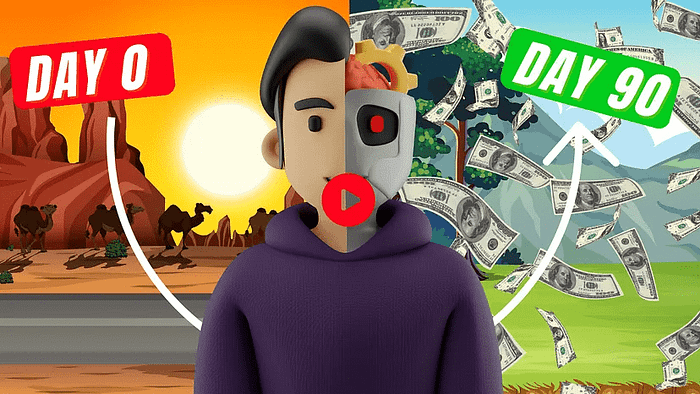10 Best ChatGPT Prompts to Supercharge Your AI Writing
Imagine having a tireless writing assistant at your fingertips, ready to help you craft compelling content day and night.
That’s the power of ChatGPT, and knowing the best ChatGPT prompts can transform your writing process.
As we dive into the world of AI-assisted writing, we’ll explore how these prompts can elevate your content creation to new heights.
From brainstorming ideas to polishing your prose, the best ChatGPT prompts are your secret weapon in the digital age.
Whether you’re a seasoned writer or just starting out, these prompts will help you harness the full potential of AI to supercharge your writing.
Get ready to discover the top 10 best ChatGPT prompts that will revolutionize your approach to content creation.
These carefully curated prompts will not only save you time but also spark your creativity and help you produce high-quality content consistently.
Let’s embark on this journey to master the art of prompt engineering and unlock the true potential of AI-assisted writing.
We strongly recommend that you check out our guide on how to take advantage of AI in today’s passive income economy.
Table of Contents
1. The Idea Generator: Sparking Creativity with AI
When writer’s block strikes, having a reliable source of inspiration can be a game-changer.
This is where one of the best ChatGPT prompts comes into play: the idea generator.
By using a prompt like “Generate 10 unique blog post ideas about [your topic],” you can quickly overcome creative roadblocks.
This prompt taps into ChatGPT’s vast knowledge base, providing you with a diverse range of ideas to explore.
The beauty of this prompt lies in its versatility – it can be applied to any niche or industry.
Whether you’re writing about technology, fashion, or sustainable living, ChatGPT can offer fresh perspectives and angles.
As you review the generated ideas, you’ll often find unexpected connections and novel approaches to your topic.
This prompt not only saves time but also expands your creative horizons, pushing you to consider ideas you might not have thought of on your own.
Maximizing the Potential of Idea Generation
To get the most out of this prompt, consider adding specific parameters or constraints.
For example, you could ask for “10 controversial blog post ideas about artificial intelligence” or “5 beginner-friendly DIY project ideas for small apartments.”
The more specific you are, the more tailored and useful the results will be.
Don’t be afraid to run the prompt multiple times, tweaking it slightly each time to explore different facets of your topic.
Remember, these generated ideas are just starting points – feel free to combine, modify, or expand upon them.
The goal is to jumpstart your creativity and provide a foundation for your unique voice and expertise.
By regularly using this idea generator prompt, you’ll build a robust content pipeline and never run out of things to write about.
2. The Outline Architect: Structuring Your Content with Precision
Once you have your topic, the next challenge is organizing your thoughts into a coherent structure.
This is where another of the best ChatGPT prompts comes in handy: the outline architect.
By using a prompt like “Create a detailed outline for a 1500-word article about [your topic],” you can quickly establish a solid framework for your content.
This prompt helps you break down complex topics into manageable sections and subsections.
It ensures that your content flows logically and covers all the important aspects of your subject matter.
The outline provided by ChatGPT serves as a roadmap for your writing, helping you stay focused and organized throughout the process.
It’s particularly useful for longer-form content, where maintaining a clear structure is crucial for readability and engagement.
Refining Your Outline for Maximum Impact
To make the most of this outline architect prompt, consider adding specific requirements or elements you want to include.
For instance, you could ask for “a detailed outline with 5 main sections, each containing 3 subsections, for an article about sustainable fashion.”
This level of specificity helps ChatGPT generate a more tailored and useful outline for your needs.
Don’t hesitate to run the prompt multiple times, adjusting it based on your preferences or the specific requirements of your project.
You can also use follow-up prompts to expand on certain sections or reorganize the structure if needed.
Remember that the outline is a starting point – feel free to modify it as you write, adding or removing sections as your article evolves.
By consistently using this outline architect prompt, you’ll streamline your writing process and produce more structured, cohesive content.
3. The Research Assistant: Gathering Information Efficiently
In the realm of content creation, thorough research is often the foundation of compelling writing.
This is where one of the best ChatGPT prompts shines: the research assistant.
By using a prompt like “Provide key statistics and recent developments about [your topic],” you can quickly gather relevant information for your article.
This prompt leverages ChatGPT’s extensive knowledge base to offer you a concise summary of important facts and trends.
It’s an excellent way to ensure your content is up-to-date and backed by solid data.
The research assistant prompt can save you hours of manual searching and help you identify the most pertinent information for your piece.
It’s particularly useful when writing about complex or rapidly evolving topics, where staying current is crucial.
This prompt can also help you uncover interesting angles or lesser-known facts that can make your content stand out.
Maximizing the Value of AI-Assisted Research
To get the most out of this research assistant prompt, consider specifying the type of information you’re looking for.
For example, you could ask for “5 surprising statistics about renewable energy adoption in the last 2 years” or “Recent breakthroughs in artificial intelligence and their potential applications.”
The more specific your request, the more targeted and useful the information you’ll receive will be.
Don’t forget to fact-check the information provided by ChatGPT, especially for recent developments or specific statistics.
While ChatGPT is a powerful tool, it’s always good practice to verify important facts from primary sources.
You can also use follow-up prompts to dig deeper into specific aspects of your research or to request additional context for certain points.
By regularly employing this research assistant prompt, you’ll be able to quickly gather high-quality information, enhancing the depth and credibility of your content.
4. The Engaging Introduction Crafter: Hooking Your Readers from the Start
The introduction of your article can make or break reader engagement.
That’s why one of the best ChatGPT prompts focuses on crafting compelling introductions.
By using a prompt like “Write an engaging introduction for an article about [your topic] that hooks the reader,” you can create a powerful opening for your piece.
This prompt helps you overcome the challenge of the blank page and sets the tone for your entire article.
A well-crafted introduction grabs the reader’s attention, presents the topic’s relevance, and provides a roadmap for what’s to come.
ChatGPT can generate various styles of introductions, from thought-provoking questions to surprising statistics or vivid scenarios.
This variety allows you to choose the approach that best fits your topic and target audience.
The introduction crafter prompt is especially useful when you’re dealing with complex or potentially dry topics that need an extra spark to engage readers.
Perfecting Your Article’s Opening
To maximize the effectiveness of this introduction crafter prompt, consider specifying the tone or style you want.
For instance, you could request “a humorous introduction for an article about personal finance” or “a dramatic opening for a piece on climate change.”
This level of detail helps ChatGPT generate an introduction that aligns closely with your vision for the article.
Don’t be afraid to generate multiple introductions and combine elements from different versions to create the perfect opening.
Remember that while ChatGPT provides a great starting point, you should always infuse your own voice and style into the introduction.
You can also use follow-up prompts to refine specific aspects of the introduction, such as making it more concise or emphasizing a particular point.
By consistently using this introduction crafter prompt, you’ll be able to create attention-grabbing openings that compel readers to dive into your content.
5. The Analogy Architect: Simplifying Complex Concepts
When dealing with intricate topics, analogies can be powerful tools for enhancing understanding.
This is where another of the best ChatGPT prompts comes into play: the analogy architect.
By using a prompt like “Create an analogy to explain [complex concept] in simple terms,” you can make challenging ideas more accessible to your readers.
This prompt taps into ChatGPT’s creative capabilities to draw parallels between complex concepts and everyday experiences.
A well-crafted analogy can bridge the gap between the unfamiliar and the familiar, making your content more relatable and memorable.
The analogy architect prompt is particularly useful when writing about technical, scientific, or abstract topics that might otherwise be difficult for a general audience to grasp.
It helps you translate complex ideas into language that resonates with your readers, improving engagement and comprehension.
This prompt can also spark your own creativity, inspiring you to develop even more fitting analogies as you write.
Crafting Powerful Analogies for Maximum Impact
To get the most out of this analogy architect prompt, consider specifying the target audience or the desired tone of the analogy.
For example, you could ask for “an analogy to explain blockchain technology to teenagers” or “a sports-related analogy to describe the process of photosynthesis.”
The more specific you are, the more tailored and effective the resulting analogy will be.
Don’t hesitate to generate multiple analogies and combine or refine them to create the perfect explanation for your content.
Remember that while ChatGPT provides a great starting point, you should always evaluate the analogy’s accuracy and appropriateness for your specific context.
You can also use follow-up prompts to expand on certain aspects of the analogy or to request alternative comparisons if the first one doesn’t quite fit.
By consistently using this analogy architect prompt, you’ll be able to break down complex ideas into digestible, engaging content that resonates with your audience.
6. The Counterargument Generator: Strengthening Your Position
In persuasive writing, addressing potential counterarguments is crucial for building a robust case.
This is where one of the best ChatGPT prompts proves invaluable: the counterargument generator.
By using a prompt like “Generate three potential counterarguments to the claim that [your main point],” you can anticipate and address opposing viewpoints.
This prompt helps you think critically about your own position and identify potential weaknesses in your argument.
By considering counterarguments, you demonstrate a balanced approach and strengthen your credibility with readers.
The counterargument generator is particularly useful when writing opinion pieces, argumentative essays, or any content that takes a strong stance on a topic.
It helps you create more nuanced, well-rounded content that acknowledges the complexity of the issue at hand.
This prompt can also inspire you to conduct further research, ensuring that your article is thoroughly informed and persuasive.
Leveraging Counterarguments for Stronger Content
To maximize the effectiveness of this counterargument generator prompt, consider specifying the perspective or background of potential opponents.
For instance, you could ask for “counterarguments to renewable energy adoption from an economic perspective” or “objections to remote work policies from traditional management viewpoints.”
This level of detail helps ChatGPT generate more relevant and challenging counterarguments for you to address.
Don’t shy away from generating multiple sets of counterarguments to explore different angles of opposition to your main point.
Remember that the goal is not just to list counterarguments, but to address them effectively in your content.
You can use follow-up prompts to brainstorm rebuttals or to explore ways to incorporate these counterarguments into your article structure.
By consistently using this counterargument generator prompt, you’ll create more balanced, persuasive content that anticipates and addresses reader concerns.
7. The Transition Smoother: Enhancing Flow and Coherence
Smooth transitions between paragraphs and sections are crucial for maintaining reader engagement and logical flow.
This is where another of the best ChatGPT prompts comes in handy: the transition smoother.
By using a prompt like “Create a smooth transition between these two paragraphs: [Paragraph 1] and [Paragraph 2],” you can improve the coherence of your writing.
This prompt helps you bridge ideas and maintain a seamless flow throughout your article.
Well-crafted transitions guide your readers from one point to the next, making your content easier to follow and more enjoyable to read.
The transition smoother is particularly useful when you’re struggling to connect different sections of your article or when you’re incorporating diverse ideas into a cohesive whole.
It can help you identify logical connections between seemingly disparate points, enhancing the overall structure of your piece.
This prompt can also inspire you to think more critically about the relationships between different parts of your content, leading to more cohesive writing overall.
Mastering the Art of Smooth Transitions
To get the most out of this transition smoother prompt, consider specifying the type of relationship you want to establish between the paragraphs.
For example, you could ask for “a transition that shows contrast between these two paragraphs” or “a transition that builds upon the idea in the first paragraph to introduce the second.”
The more specific you are, the more tailored and effective the resulting transition will be.
Don’t hesitate to generate multiple transitions and refine them to fit perfectly within your content.
Remember that while ChatGPT provides a great starting point, you should always ensure the transition aligns with your writing style and the overall tone of your article.
You can also use follow-up prompts to refine specific aspects of the transition, such as making it more concise or emphasizing a particular connection.
By consistently using this transition smoother prompt, you’ll create more cohesive, flowing content that keeps readers engaged from start to finish.
8. The Tone Adjuster: Tailoring Your Voice to Your Audience
Adapting your writing tone to suit your target audience is crucial for effective communication.
This is where one of the best ChatGPT prompts shines: the tone adjuster.
By using a prompt like “Rewrite this paragraph in a [specific tone] for a [target audience],” you can fine-tune your content’s voice.
This prompt helps you tailor your writing style to resonate with your intended readers, whether they’re professionals, students, or casual blog visitors.
A well-adjusted tone can significantly enhance reader engagement and comprehension of your message.
The tone adjuster is particularly useful when you’re writing for diverse audiences or when you need to adapt existing content for a different platform or demographic.
It helps you maintain consistency in your brand voice while ensuring your content is appropriate and appealing to each specific audience.
This prompt can also help you experiment with different writing styles, expanding your versatility as a writer.
Perfecting Your Content’s Tone
To maximize the effectiveness of this tone adjuster prompt, be as specific as possible about your target audience and desired tone.
For instance, you could ask to “rewrite this paragraph in a professional tone for C-level executives” or “adapt this content for a casual, friendly tone aimed at millennials.”
The more details you provide, the more accurately ChatGPT can adjust the tone to meet your needs.
Don’t be afraid to generate multiple versions with different tones and compare them to find the most effective approach.
Remember that while ChatGPT can provide excellent suggestions, you should always review and refine the adjusted content to ensure it aligns perfectly with your brand voice and messaging.
You can use follow-up prompts to fine-tune specific aspects of the tone, such as making it more empathetic, authoritative, or humorous.
By consistently using this tone adjuster prompt, you’ll create more targeted, effective content that resonates strongly with your intended audience.
9. The Conclusion Craftsman: Ending Your Article with Impact
A powerful conclusion can leave a lasting impression on your readers and reinforce your main points.
This is where another of the best ChatGPT prompts proves invaluable: the conclusion craftsman.
By using a prompt like “Write a compelling conclusion for an article about [your topic] that summarizes key points and leaves the reader with a thought-provoking final statement,” you can create a strong ending for your piece.
This prompt helps you wrap up your article effectively, tying together the main ideas and providing closure for your readers.
A well-crafted conclusion not only summarizes your content but also leaves readers with something to ponder or act upon.
The conclusion craftsman is particularly useful when you’re struggling to find the right way to end your article or when you want to ensure your conclusion has maximum impact.
It can help you avoid common pitfalls like introducing new information or abruptly ending your piece without proper resolution.
This prompt can also inspire you to think about the broader implications of your topic, encouraging readers to continue engaging with the subject beyond your article.
Mastering the Art of Impactful Conclusions
To get the most out of this conclusion craftsman prompt, consider specifying the type of impact you want to make on your readers.
For example, you could ask for “a conclusion that calls the reader to action” or “a conclusion that leaves the reader with a thought-provoking question about the future of [your topic].”
The more specific you are about your desired outcome, the more tailored and effective the conclusion will be.
Don’t hesitate to generate multiple conclusions and combine elements from different versions to create the perfect ending for your article.
Remember that while ChatGPT provides an excellent starting point, you should always infuse your own voice and ensure the conclusion aligns with the overall tone and message of your piece.
You can use follow-up prompts to refine specific aspects of the conclusion, such as making it more concise or emphasizing a particular key takeaway.
By consistently using this conclusion craftsman prompt, you’ll create powerful endings that leave a lasting impression on your readers and reinforce the value of your content.
10. The Headline Hacker: Crafting Attention-Grabbing Titles
In the world of digital content, a compelling headline can make the difference between a widely-read article and one that goes unnoticed.
This is where the last of our best ChatGPT prompts comes into play: the headline hacker.
By using a prompt like “Generate 10 attention-grabbing headlines for an article about [your topic],” you can create titles that entice readers to click and engage with your content.
This prompt taps into ChatGPT’s creative capabilities to produce a variety of headline styles, from intriguing questions to bold statements.
A well-crafted headline not only captures attention but also accurately represents the content of your article, setting appropriate expectations for readers.
The headline hacker prompt is particularly useful when you’re struggling to encapsulate your article’s essence in a few words or when you want to experiment with different headline styles.
It can help you brainstorm multiple options quickly, allowing you to choose the most effective one for your target audience and platform.
This prompt can also inspire you to think about your content from different angles, potentially uncovering new and interesting ways to frame your topic.
Maximizing the Impact of Your Headlines
To get the most out of this headline hacker prompt, consider specifying the type of headline you want or the platform where it will be used.
For instance, you could ask for “5 listicle-style headlines for a LinkedIn article about productivity tips” or “3 question-based headlines for a blog post about sustainable fashion.”
The more specific you are about your requirements, the more tailored and effective the generated headlines will be.
Don’t be afraid to mix and match elements from different generated headlines to create the perfect title for your content.
Remember that while ChatGPT provides great suggestions, you should always evaluate the headlines for accuracy, relevance, and alignment with your brand voice.
You can use follow-up prompts to refine specific aspects of the headlines, such as incorporating keywords or adjusting the tone.
By consistently using this headline hacker prompt, you’ll create attention-grabbing titles that increase click-through rates and draw more readers to your valuable content.
Conclusion: Harnessing the Power of AI for Enhanced Writing
As we’ve explored throughout this article, the best ChatGPT prompts are powerful tools that can revolutionize your writing process.
From generating ideas and structuring your content to crafting engaging introductions and compelling conclusions, these prompts cover every aspect of content creation.
By incorporating these best ChatGPT prompts into your workflow, you can significantly enhance your productivity and the quality of your writing.
The idea generator and research assistant prompts help you overcome writer’s block and gather information efficiently.
The outline architect and transition smoother ensure your content is well-structured and flows seamlessly.
Prompts like the analogy architect and counterargument generator help you explain complex concepts and strengthen your arguments.
The tone adjuster and headline hacker allow you to fine-tune your content for maximum impact and reach.
Remember, these best ChatGPT prompts are not meant to replace your creativity but to augment it.
They provide a starting point, offering fresh perspectives and ideas that you can build upon with your unique insights and expertise.
As with any tool, the key to success lies in how you use it.
Experiment with these prompts, adapt them to your needs, and always infuse your personal touch into the final product.
With practice, you’ll find that these best ChatGPT prompts become an indispensable part of your writing toolkit, helping you create more engaging, informative, and impactful content.
Embrace the power of AI-assisted writing, but never lose sight of your unique voice and vision as a writer.
By striking the right balance between AI assistance and human creativity, you can truly supercharge your writing and take your content to new heights.
So, dive in, explore these best ChatGPT prompts, and watch as your writing process transforms and your content soars to new levels of excellence.
Frequently Asked Questions (FAQ)
How to write ChatGPT prompts to get the best results?
Writing effective ChatGPT prompts is key to getting the best results from the AI.
Here are some tips to help you craft prompts that yield optimal outcomes:
Be specific and clear in your requests, providing context and details about what you want.
Use descriptive language to guide the AI’s tone, style, and format of the response.
Break down complex tasks into smaller, more manageable prompts for better results.
Experiment with different phrasings and approaches to find what works best for your needs.
Include examples or templates if you have a specific output format in mind.
Don’t hesitate to use follow-up prompts to refine or expand on the initial response.
Remember, practice and experimentation will help you develop a feel for crafting effective prompts.
What should I ask ChatGPT?
ChatGPT is a versatile tool that can assist with a wide range of tasks and queries.
Here are some ideas for what you can ask ChatGPT:
Request explanations of complex concepts or topics you’re trying to understand.
Ask for creative ideas for writing, such as story prompts or character development.
Seek assistance with problem-solving or brainstorming for personal or professional projects.
Request help with language tasks like translations, grammar checks, or vocabulary expansion.
Ask for summaries of lengthy texts or articles to save time on research.
Seek advice on various topics, keeping in mind that ChatGPT’s knowledge has limitations and cutoff dates.
Use it for coding help, including debugging, explaining code snippets, or suggesting algorithms.
Remember, while ChatGPT is knowledgeable, always verify critical information from authoritative sources.
How to optimize prompts for ChatGPT?
Optimizing your prompts for ChatGPT can significantly improve the quality and relevance of the responses you receive.
Here are some strategies to optimize your prompts:
Start with a clear objective: Know exactly what you want to achieve with your prompt.
Use specific instructions: Tell ChatGPT exactly what you want, including format, tone, and length.
Provide context: Give background information to help ChatGPT understand the full picture.
Use examples: If you have a specific output in mind, provide an example to guide the AI.
Break down complex requests: For intricate tasks, use a series of prompts rather than one long, complicated one.
Experiment with different phrasings: If you’re not getting the desired results, try rewording your prompt.
Utilize system messages: Set the stage for your conversation by defining ChatGPT’s role or the context of your interaction.
Remember, optimizing prompts is an iterative process, so don’t be afraid to refine and adjust as needed.
How to prompt ChatGPT to be an expert?
While ChatGPT can’t truly become an expert in the human sense, you can prompt it to provide more specialized or in-depth responses.
Here are some strategies to get more expert-like responses from ChatGPT:
Define the expert role: Start your prompt by asking ChatGPT to assume the role of an expert in a specific field.
Provide context: Give background information about the level of expertise you’re seeking and the specific area of focus.
Ask for technical or specialized language: Request that responses include field-specific terminology or concepts.
Request citations or references: Ask for information sources, keeping in mind that ChatGPT may not always provide accurate citations.
Use follow-up questions: Dive deeper into topics with additional prompts to explore more complex aspects of the subject.
Ask for pros and cons or multiple perspectives: This can help simulate a more nuanced, expert-level analysis.
Request step-by-step explanations: For complex processes or concepts, ask for detailed, sequential breakdowns.
Remember, while ChatGPT can provide detailed and informative responses, it’s not a substitute for real human expertise, especially in critical fields like medicine or law.

We strongly recommend that you check out our guide on how to take advantage of AI in today’s passive income economy.




